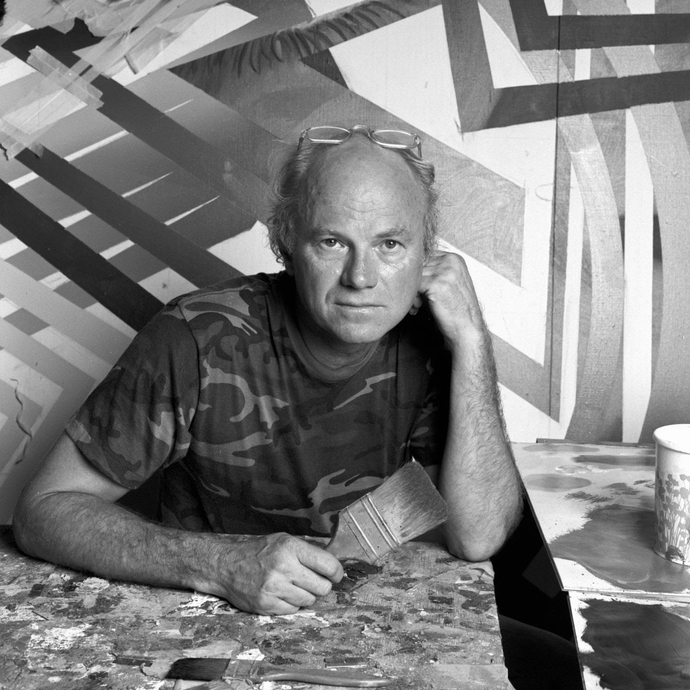
James Rosenquist
James Rosenquist, an American artist and a leading figure in the pop art movement, delved deeply into the influence of advertising and consumer culture on both art and society. His artworks frequently incorporated elements of surrealism, skillfully weaving together fragments of advertisements and cultural imagery. Through this technique, Rosenquist aimed to underscore the pervasive and overpowering impact of advertising in contemporary life.
Biography of James Rosenquist
James Rosenquist was born in 1933 in Grand Forks, North Dakota, USA. He began his artistic journey with a short-term scholarship at the Minneapolis School of Art, followed by painting studies at the University of Minnesota from 1952 to 1954. Seeking further artistic growth, in 1955, he relocated to New York City to attend the Art Students League, where he studied under notable painters like Edwin Dickinson and George Grosz.
Fascinated by the vibrant urban landscape, Rosenquist joined the International Brotherhood of Painters and Allied Trades, becoming involved in painting billboards around Times Square. His talent quickly rose, leading him to become the lead painter for Artkraft-Strauss, adorning displays and windows along Fifth Avenue. However, a tragic incident in 1960, where a friend perished in a scaffold fall, prompted Rosenquist to step away from billboard painting.
In the early 1960s, Rosenquist gained recognition with his first solo exhibitions at the Green Gallery in 1962 and 1963. His breakthrough came in 1965 with the display of his monumental painting "F-111" at the Leo Castelli Gallery, garnering international acclaim.
In 1971, Rosenquist embarked on a new chapter in South Florida, accepting an invitation from Donald Saff, dean of the University of South Florida's College of Fine Arts, to participate in the school's Graphicstudio, a collaborative art endeavor. Establishing his Aripeka studio in 1976, Rosenquist continued to produce innovative and influential works.
After a prolific career marked by significant contributions to contemporary art, James Rosenquist passed away at his New York City residence on March 31, 2017, following a prolonged illness. His legacy endures through his groundbreaking art and enduring impact on the art world.
James Rosenquist's Art Style
Rosenquist's artistic style was defined by a unique blend of techniques and imagery reminiscent of his earlier work as a billboard painter. Even after departing from this profession, he retained the bold hues, expansive scale, and vivid imagery characteristic of his billboard paintings.
Transitioning from school to various odd jobs, Rosenquist eventually found himself in the realm of sign painting. From 1957 to 1960, he honed his craft as a billboard painter, mastering techniques that would later influence his fine art endeavors. Embracing the visual language of advertising and popular culture, Rosenquist, like other pop artists of his time, seamlessly integrated these elements into his large-scale paintings, marking a significant departure from traditional art forms.
The 1970s brought forth a period of personal turmoil for Rosenquist as he grappled with tragedy following a devastating automobile accident involving his wife and son. This event deeply affected him emotionally and psychologically, impacting his artistic output for the next several years.
Despite these challenges, Rosenquist persisted in creating monumental works throughout the 1980s. By the 1990s, he shifted his focus primarily to large-scale prints, including the monumental "Time Dust," widely regarded as one of the largest prints ever produced.
One of Rosenquist's earliest works to embrace monumental scale was the "Zone," a seminal piece that marked his foray into pop art. This oil painting, executed on two separate canvases, exemplifies the artist's penchant for incorporating imagery from mass media, such as a tomato and a hand cream advertisement, into his fragmented and surreal compositions.
"President Elect" further exemplifies Rosenquist's exploration of mass media and consumerism. Depicting a towering portrait of John F. Kennedy juxtaposed with commercial imagery like a hand holding a cake and the rear end of a Chevrolet, the painting serves as a commentary on the burgeoning influence of advertising and mass media during Kennedy's campaign.
However, "F-111," completed in 1965, solidified Rosenquist's reputation as a master of large-scale art. This monumental piece spans over 83 feet and comprises 23 canvases, featuring a life-sized depiction of the F-111 Aardvark aircraft intertwined with images of war and commercial products. Through this work, Rosenquist provocatively questions the intersection of marketing and the media's portrayal of war, inviting viewers to contemplate the complex relationship between consumer culture and global conflict.
Years:
Born in 1933
Country:
United States of America, Grand Forks, North Dakota
Gallery: